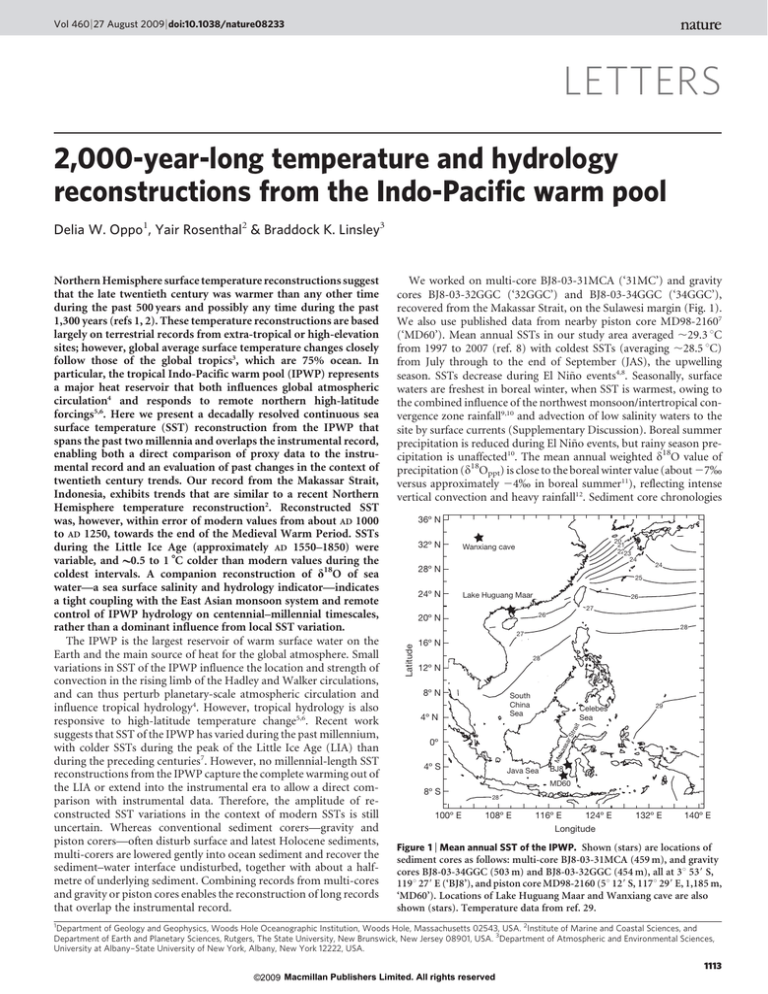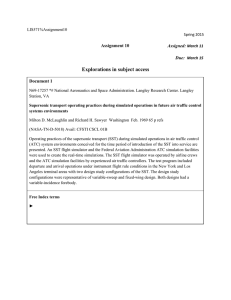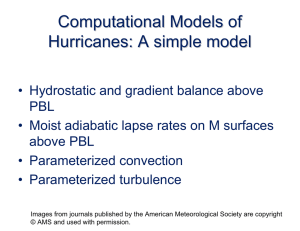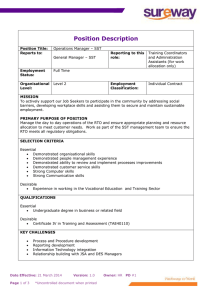
Vol 460 | 27 August 2009 | doi:10.1038/nature08233
LETTERS
2,000-year-long temperature and hydrology
reconstructions from the Indo-Pacific warm pool
Delia W. Oppo1, Yair Rosenthal2 & Braddock K. Linsley3
We worked on multi-core BJ8-03-31MCA (‘31MC’) and gravity
cores BJ8-03-32GGC (‘32GGC’) and BJ8-03-34GGC (‘34GGC’),
recovered from the Makassar Strait, on the Sulawesi margin (Fig. 1).
We also use published data from nearby piston core MD98-21607
(‘MD60’). Mean annual SSTs in our study area averaged ,29.3 uC
from 1997 to 2007 (ref. 8) with coldest SSTs (averaging ,28.5 uC)
from July through to the end of September (JAS), the upwelling
season. SSTs decrease during El Niño events4,8. Seasonally, surface
waters are freshest in boreal winter, when SST is warmest, owing to
the combined influence of the northwest monsoon/intertropical convergence zone rainfall9,10 and advection of low salinity waters to the
site by surface currents (Supplementary Discussion). Boreal summer
precipitation is reduced during El Niño events, but rainy season precipitation is unaffected10. The mean annual weighted d18O value of
precipitation (d18Oppt) is close to the boreal winter value (about 27%
versus approximately 24% in boreal summer11), reflecting intense
vertical convection and heavy rainfall12. Sediment core chronologies
36º N
32º N
20
21
2223
24
Wanxiang cave
28º N
24
25
24º N
Lake Huguang Maar
26
27
26
20º N
28
27
Latitude
16º N
28
12º N
8º N
South
China
Sea
Celebes
Sea
29
rS
tra
it
4º N ka
ssa
0º Ma
Northern Hemisphere surface temperature reconstructions suggest
that the late twentieth century was warmer than any other time
during the past 500 years and possibly any time during the past
1,300 years (refs 1, 2). These temperature reconstructions are based
largely on terrestrial records from extra-tropical or high-elevation
sites; however, global average surface temperature changes closely
follow those of the global tropics3, which are 75% ocean. In
particular, the tropical Indo-Pacific warm pool (IPWP) represents
a major heat reservoir that both influences global atmospheric
circulation4 and responds to remote northern high-latitude
forcings5,6. Here we present a decadally resolved continuous sea
surface temperature (SST) reconstruction from the IPWP that
spans the past two millennia and overlaps the instrumental record,
enabling both a direct comparison of proxy data to the instrumental record and an evaluation of past changes in the context of
twentieth century trends. Our record from the Makassar Strait,
Indonesia, exhibits trends that are similar to a recent Northern
Hemisphere temperature reconstruction2. Reconstructed SST
was, however, within error of modern values from about AD 1000
to AD 1250, towards the end of the Medieval Warm Period. SSTs
during the Little Ice Age (approximately AD 1550–1850) were
variable, and 0.5 to 1 6C colder than modern values during the
coldest intervals. A companion reconstruction of d18O of sea
water—a sea surface salinity and hydrology indicator—indicates
a tight coupling with the East Asian monsoon system and remote
control of IPWP hydrology on centennial–millennial timescales,
rather than a dominant influence from local SST variation.
The IPWP is the largest reservoir of warm surface water on the
Earth and the main source of heat for the global atmosphere. Small
variations in SST of the IPWP influence the location and strength of
convection in the rising limb of the Hadley and Walker circulations,
and can thus perturb planetary-scale atmospheric circulation and
influence tropical hydrology4. However, tropical hydrology is also
responsive to high-latitude temperature change5,6. Recent work
suggests that SST of the IPWP has varied during the past millennium,
with colder SSTs during the peak of the Little Ice Age (LIA) than
during the preceding centuries7. However, no millennial-length SST
reconstructions from the IPWP capture the complete warming out of
the LIA or extend into the instrumental era to allow a direct comparison with instrumental data. Therefore, the amplitude of reconstructed SST variations in the context of modern SSTs is still
uncertain. Whereas conventional sediment corers—gravity and
piston corers—often disturb surface and latest Holocene sediments,
multi-corers are lowered gently into ocean sediment and recover the
sediment–water interface undisturbed, together with about a halfmetre of underlying sediment. Combining records from multi-cores
and gravity or piston cores enables the reconstruction of long records
that overlap the instrumental record.
4º S
Java Sea
BJ8
MD60
8º S
100º E
28
108º E
116º E
124º E
Longitude
132º E
140º E Figure 1 | Mean annual SST of the IPWP. Shown (stars) are locations of
sediment cores as follows: multi-core BJ8-03-31MCA (459 m), and gravity
cores BJ8-03-34GGC (503 m) and BJ8-03-32GGC (454 m), all at 3u 539 S,
119u 279 E (‘BJ8’), and piston core MD98-2160 (5u 129 S, 117u 299 E, 1,185 m,
‘MD60’). Locations of Lake Huguang Maar and Wanxiang cave are also
shown (stars). Temperature data from ref. 29.
1
Department of Geology and Geophysics, Woods Hole Oceanographic Institution, Woods Hole, Massachusetts 02543, USA. 2Institute of Marine and Coastal Sciences, and
Department of Earth and Planetary Sciences, Rutgers, The State University, New Brunswick, New Jersey 08901, USA. 3Department of Atmospheric and Environmental Sciences,
University at Albany–State University of New York, Albany, New York 12222, USA.
1113
©2009 Macmillan Publishers Limited. All rights reserved
LETTERS
NATURE | Vol 460 | 27 August 2009
a
30
SST (°C)
are based on 210Pb (31MC), radiocarbon dating, and a correlation to
the AD 1815 Mount Tambora ash tentatively identified in MD607
(Supplementary Methods). High sediment accumulation rates
(,100–200 cm kyr21) enable decadal-scale resolution. To reconstruct
d18O of sea water (SST and d18Osw), we generated Mg/Ca and d18O
data on the planktonic foraminifera, Globigerinoides ruber (sensu
stricto morphotype), which inhabits the surface mixed layer
(Methods). Sediment trap data indicate that in the tropics, the seasonal preference of G. ruber varies among locations, ranging from a
cold season (upwelling) preference to a warm season preference13–15
(Supplementary Discussion).
We converted Mg/Ca to SST using a calibration, Mg/
Ca 5 0.38exp(0.09SST), based on seasonal Mg/Ca variations in multiple species of planktonic foraminifera from Sargasso Sea sediment
trap samples16 (Fig. 2a). Our reconstructed SSTs generally fall
between historical mean annual and JAS SSTs (the National
Oceanic and Atmospheric Administration extended SST reconstruction8, ERSSTv3; Fig. 2), suggesting that the seasonal flux of G. ruber to
the sediment (G. ruber seasonality) in our study area varied through
time, with a greater flux to the sediment in JAS during cooler periods
(for example, around AD 1900–50) relative to warm periods, when
reconstructed SSTs approach the annual mean.
We applied the Mg/Ca–SST calibration16 to data from all four cores
(Fig. 2b). Following previous studies7,17–19, we also reconstructed
29
1997–2007 mean annual SST
28
JAS
27
SST (°C)
b
30
1880
1900
1920 1940
Year AD
1960
1980
2000
5.7
1997–2007 mean annual SST
29
5.2
28
4.7
27
4.3
JAS
Mg/Ca (mmol mol–1)
1860
3.9
26
δ18 Osw (‰ SMOW)
c 0.2
–0.2
–0.6
–1.0
500 BC
0
500
1000
1500
2000
Year AD
Figure 2 | Sea surface temperature and d18Osw reconstructions.
a, ERSSTv38 mean annual (red line) and JAS (green line) SST
reconstructions based on the instrumental record for the grid box
containing the BJ8 core sites. Blue line, Mg/Ca-based SST estimates using a
published calibration16. Crosses, Mg/Ca-based SST estimates. Lines are
three-point running means. b, Downcore SST, and c, d18Osw reconstructions
(31MC, blue crosses; MD60, red crosses; 34GGC, green crosses; 32GGC
black circles). Colour-coded lines are three-point running means. Upper and
lower horizontal lines in a and b are modern (1997–2007) mean annual and
JAS SST8 at the BJ8 core sites, respectively. Colour-coded triangles in
b denote radiocarbon age control, except for the most recent red triangle,
which denotes the Mt Tambora ash, tentatively identified in MD60
(Supplementary Notes). d18Osw values are relative to Vienna Standard Mean
Ocean Water (VSMOW).
d18Osw from the d18O of G. ruber (Supplementary Data) and our
SST estimates (Fig. 2c). The SST reconstruction shows cooler temperatures between about AD 400 and AD 950 than during much of the
so-called Medieval Warm Period (about AD 900–1300), a warm period
found in many northern high-latitude records but whose global significance is uncertain1. A gradual SST decrease began at about AD
1300, and culminated at about AD 1700, within the peak of the LIA.
Subsequent warming was interrupted by two multi-decadal cold
periods, one towards the end of the LIA and one during the early
twentieth century. Each was nearly as cold as the coldest LIA peak.
At face value, our reconstruction suggests that peak LIA SSTs were
,1 uC and 1.5 uC colder than late twentieth century JAS and mean
annual SST, respectively. Given the possibility raised by our comparison of reconstructed SST to the instrumental record (Fig. 2a) that
the flux of G. ruber to the sediment was higher in JAS during the LIA
than at present, we favour a conservative interpretation that JAS
surface waters were ,1 uC colder than late twentieth century JAS
SSTs. Considering that from 1856 to 20078, the amplitude of mean
annual SST variability averaged ,70% of the amplitude of JAS SSTs
variability (Supplementary Discussion), we infer that mean annual
SSTs were ,0.5 to 1 uC colder than the late twentieth century.
Reconstructed SSTs were warmest from AD 1000 to AD 1250 and
during short periods of first millennium (Fig. 2b). Given the evidence
that G. ruber tends to record near mean annual SSTs during warm
intervals of the last 150 years (Fig. 2a), reconstructed SSTs during these
warm periods probably reflect mean annual SSTs. If this is the case, as
we suspect, then SSTs within error of modern SSTs occurred in the
IPWP during the Medieval Warm Period and during brief periods of
the first millennium AD. If, on the other hand, G. ruber calcified
preferentially during the JAS upwelling season throughout the study
interval, then JAS SSTs as warm as modern also characterized the
previous millennium. Regardless of G. ruber seasonality in this region,
the reconstruction suggests that at least during the Medieval Warm
Period, and possibly the preceding 1,000 years, Indonesian SSTs were
similar to modern SSTs.
To estimate errors and facilitate comparison to other records,
we developed composite records (Fig. 3; Methods Summary). Our
averaging scheme reduces the amplitude of the records, but preserves
only the most robust features. Considering the age uncertainties in our
reconstruction, long-term SST trends are similar to those in Northern
Hemisphere temperature reconstructions, especially the ‘NH land
error-in-variables (EIV) composite’2 (r2 5 0.5, P = 0.00001; Fig. 3a),
consistent with the instrumental record, which suggests that
Indonesian SST is correlated to global SST and air temperature on
multi-decadal and longer timescales (Supplementary Notes). (Here
NH indicates Northern Hemisphere.) Contrary to the Indonesia SST
reconstruction, however, the Northern Hemisphere temperature
reconstruction does not estimate temperatures as warm as modern
at any time during the past two millennia. The hemispheric and global
temperature difference between the early AD 1900s and the modern era
is similar to the difference in mean annual SST at our core site
(Supplementary Notes), so the greater amplitude of Makassar Strait
SST than Northern Hemisphere temperature variability (note different axis scaling in Fig. 3a) may be related to the hypothesized changes
in G. ruber seasonality. We note that the high-amplitude variations
resulting from these hypothesized changes in G. ruber seasonality also
preclude accurate estimates of the rates of SST change in the past and a
meaningful comparison to the rate of SST increase during the past
decade.
Long-term d18Osw trends are also similar to Northern Hemisphere
temperature trends (r2 5 0.3, P=0.0001) with the lowest values
during the coldest peak of the LIA (Fig. 3b). The d18Osw decrease that
began at about AD 1300 was linked to gradual Northern Hemisphere
and IPWP cooling, and the subsequent increase in d18Osw values
associated with nineteenth- and twentieth-century warming. This
general trend of increasing d18Osw was punctuated by two multidecadal d18Osw minima, each with slightly higher d18Osw values. By
1114
©2009 Macmillan Publishers Limited. All rights reserved
All India rainfall (mm)
28
–1
27
1
0.2
0.0
–0.2
0
–0.4
–0.6
–1
–8.5
d
–7.5
0
–0.2
–0.4
–0.6
–0.8
0.2
0.0
–0.2
3,000
–0.4
–0.6
0
500
1000
Year AD
1500
890
0.0
870
–0.2
850
–0.8
2000
Figure 3 | Comparison of composite Indonesia records to hemispheric and
regional records. a, Composite SST and b, d18Osw records (black) versus
Northern Hemisphere land EIV composite temperature (T) anomaly2 (red).
c, Composite d18Osw record (black) versus d18O of Wanxiang cave, a summer
monsoon record23 (green) and d, Lake Huguang Maar magnetic susceptibility,
a winter monsoon record24 (orange). Upper and lower horizontal lines in a are
modern (1997–2007) mean annual and JAS SST8 at the BJ8 core sites,
respectively. Composite records were developed by averaging data in 10-year
overlapping, 50-year-long bins. Error bars (grey), 61 standard error of data in
each bin. Wanxiang cave and Lake Huguang Maar data were also averaged in
10-year overlapping 50-year bins for clarity. The approximate time interval of
the Little Ice Age (LIA) is denoted by the horizontal bar in a.
analogy with the seasonality of modern precipitation9,10, of d18Oppt
values11,12, and of surface currents (Supplementary Discussion), the
low d18Osw values indicate that the Indonesian rainfall regime from
about AD 1500 to AD 1900 was more boreal winter-like (stronger boreal
winter, weaker boreal summer monsoon) than the preceding centuries.
Additional proxy evidence, discussed below, that the boreal summer
monsoon was weaker during the LIA than during the Medieval Warm
Period suggests that the colder surface waters implied by our record
were not caused by greater monsoon-driven upwelling. El Niño events,
as recorded in lake sediments from high-altitude Ecuador20 and
Galapagos21, may have been subdued during the LIA, suggesting that
neither a higher frequency/greater intensity of El Niño events nor a
more El Niño-like mean Pacific state caused cold LIA SSTs. Rather,
cooling of North Pacific surface water, which enters the southern
Makassar Strait in boreal winter via the South China Sea/ Java Sea
pathway to the west4,22, is the likely proximal cause of LIA cooling.
Our interpretation of a more winter-like rainfall regime during the
LIA is substantiated by records from Wanxiang cave, subtropical
China23 (r2 5 0.2, P = 0.0001) and Lake Huguang Maar, coastal
southeast China24 (r2 5 0.1, P = 0.0001) (Fig. 3c and d), which
indicate weaker summer and stronger winter Asian monsoons,
respectively, during the LIA. Low Indian summer monsoon rainfall25
also corresponds to low d18Osw (greater Indonesian rainfall) on
–0.4
830
1800
–0.8
0.2
0.0
6,000
SST (°C)
0
–8.0
Magn. susc. (10–6 SI)
29
δ18Osw (‰ SMOW)
1997–2007 JAS SST
δ18O (‰ VPDB)
c
30
LIA
1997–2007 mean annual SST
δ18Osw (‰ SMOW)
NH T anomaly (°C)
b
1
δ18Osw (‰ SMOW)
NH T anomaly (°C)
a
1850
1900
Year AD
1950
δ18Osw (‰SMOW)
LETTERS
NATURE | Vol 460 | 27 August 2009
–0.6
2000
Figure 4 | Comparison of Indonesian d18Osw and Indian rainfall. Red
dashed line, 31MC d18Osw three-point running mean; red solid lines,
composite d18Osw record (thick line) with 61 standard error (thin lines);
green, All India Rainfall index25, 10-year overlapping, 50-year long bins
(thick line), with 61 standard error (thin lines).
multi-decadal timescales (Fig. 4) (r2 5 0.6, P , 0.0005). These results,
suggesting alternating precipitation maxima in the Northern
Hemisphere Asian monsoon regions and over Indonesia, add to a
growing body of evidence that monsoon/intertropical convergence
zone variations profoundly influenced the tropical hydrology of the
past two millennia7,23,24,26,27.
Modern observations and modelling studies indicate that small
changes in IPWP SSTs strongly influence the global hydrologic cycle4.
For example, cooler SSTs in some areas of the IPWP might dampen
intense deep atmospheric convection, reducing global precipitation28. However, our finding that d18Osw was lowest (and by
inference, net regional precipitation greatest) when SSTs were
cold—during the LIA (Fig. 3) and the early AD 1900s (Fig. 4)—
suggests that on multi-decadal through to millennial timescales,
IPWP precipitation anomalies are not driven by local SST anomalies,
but are remotely forced by the Asian monsoon/intertropical convergence zone.
METHODS SUMMARY
d18O and Mg/Ca were collected on G. ruber in the 212–250 mm and 250–300 mm
size-fraction, respectively. d18O was measured at WHOI on a Finnigan MAT253
stable isotope mass spectrometer with the Kiel III Carbonate Device. Long-term
precision of d18O measurements of standards is 0.07%. Mg/Ca measurements were
made at Rutgers Inorganic Analytical Laboratory using a sector field inductively
coupled plasma mass spectrometer (Thermo Element XR). Additional details,
including interlaboratory offsets and corrections, are discussed in Methods.
To construct composite records, we binned data from all four cores in 10year-overlapping 50-year-long bins. We estimated errors in two ways. First, we
took the standard error of the SST or d18Osw in each 50-year bin (grey lines in
Fig. 3). Second, we estimated errors by dividing the standard error in the SST and
d18Osw estimate by the square root of the number of data points in each bin. The
standard error in the SST calibration is 0.16 uC. The standard error of the d18Osw
is a function of the error in both d18O of calcite and the error in SST. Assuming
greater variance for geological samples than standards, we use a 0.2% standard
deviation for the d18O of calcite, and knowing the standard error in the SST
calibration, a standard error of 0.24% is estimated for d18Osw. The two methods
gave similar error estimates for SST, but the second method (data not shown;
http://www.ncdc.noaa.gov/paleo/) often suggests larger errors for d18Osw.
To estimate correlation coefficients and P values for the records shown on
Figs 3 and 4, we linearly regressed data from each of the two records, already
averaged within 10-year-overlapping 50-year-long bins.
Received 6 December 2008; accepted 15 June 2009.
1.
2.
3.
4.
5.
Jansen, E. et al. in Climate Change 2007: The Physical Science Basis (eds Solomon, S.
et al.) 466–482 (Cambridge Univ. Press, 2007).
Mann, M. E. et al. Proxy-based reconstructions of hemispheric and global surface
temperature variations over the past two millennia. Proc. Natl Acad. Sci. USA 105,
13252–13257 (2008).
National Research Council. Surface Temperature Reconstructions for the Last 2,000
Years (National Academy Press, 2006); available at Æhttp://www.nap.edu/
catalog.php?record_id511676æ.
Qu, T., Du, Y., Strachan, J., Meyers, G. & Slingo, J. Sea surface temperature and its
variability in the Indonesian region. Oceanography 18, 50–61 (2005).
Broccoli, A. J., Dahl, K. A. & Stouffer, R. J. Response of the ITCZ to northern
hemisphere cooling. Geophys. Res. Lett. 33, doi:10.1029/2005GL024546 (2006).
1115
©2009 Macmillan Publishers Limited. All rights reserved
LETTERS
6.
7.
8.
9.
10.
11.
12.
13.
14.
15.
16.
17.
18.
19.
20.
NATURE | Vol 460 | 27 August 2009
Chiang, J. C. H. & Bitz, C. M. Influence of high latitude ice cover on the marine
Intertropical Convergence Zone. Clim. Dyn. 25, 477–496 (2005).
Newton, A., Thunell, R. & Stott, L. Climate and hydrologic variability in the IndoPacific Warm Pool during the last Millennium. Geophys. Res. Lett. 33, L19710,
doi:10.1029/2006GL0273234 (2006).
Smith, T. M., Reynolds, R. W., Peterson, T. C. & Lawrimore, J. Improvements to
NOAA’s historical merged land-ocean surface temperature analysis
(1880–2006). J. Clim. 21, 2283–2296 (2008).
Xie, P. & Arkin, P. A. Analyses of global monthly precipitation using gauge
observations, satellite estimates, and numerical model predictions. J. Clim. 9,
840–858 (1996).
Aldrian, E. & Susanto, R. D. Identification of three dominant rainfall regions within
Indonesia and their relationship to sea surface temperature. Int. J. Clim. 23,
1435–1452 (2003).
International Atomic Energy Agency/World Meteorological Organization. GNIP
programme: resources. Æhttp://www-naweb.iaea.org/napc/ih/GNIP/
IHS_GNIP.htmlæ (2006).
Vuille, M., Werner, M., Bradley, R. S. & Keimig, F. Stable isotopes in precipitation in
the Asian monsoon region. J. Geophys. Res. 110, D23108, doi:10.1029/
2005JD006022 (2005).
Kawahata, H., Nishimura, A. & Gagan, M. Seasonal change in foraminiferal
production in the western equatorial Pacific warm pool: evidence from sediment
trap experiments. Deep-Sea Res. II 49, 2783–2801 (2002).
Mohtadi, M. et al. Low-latitude control on seasonal and interannual changes in
planktonic foraminiferal flux and shell geochemistry off south Java: a sediment
trap study. Paleoceanography 24, doi:10.1029/2008PA001636 (2009).
Thunell, R. C. & Reynolds, L. A. Sedimentation of planktonic foraminifera: seasonal
changes in species in the Panama Basin. Micropaleontology 30, 243–262 (1984).
Anand, P., Elderfield, H. & Conte, M. H. Calibration of Mg/Ca thermometry in
planktonic foraminifera from a sediment trap time-series. Paleoceanography 18,
doi:10.1029/2002PA000846 (2003).
Lea, D. W., Pak, D. K. & Spero, H. J. Climate impact of late Quaternary equatorial
Pacific sea surface temperature variations. Science 289, 1719–1724 (2000).
Stott, L. et al. Decline of western Pacific surface ocean salinity and temperature in
the early Holocene. Nature 431, 56–59 (2004).
Rosenthal, Y., Oppo, D. W. & Linsley, B. K. The amplitude and phasing of climate
change during the last deglaciation in the Sulu Sea, western equatorial Pacific.
Geophys. Res. Lett. 30, doi:10.1029/2002GL016612 (2003).
Moy, C. M., Seltzer, G. O., Rodbell, D. T. & Anderson, D. M. Variability of El Niño/
Southern Oscillation activity at millennial timescales during the Holocene epoch.
Nature 420, 162–165 (2002).
21. Conroy, J. L., Overpeck, J. T., Cole, J. E., Shanahan, T. M. & Steinitz-Kannan, M.
Holocene changes in eastern tropical Pacific climate inferred from a Galapagos
lake sediment record. Quat. Sci. Rev. 27, 1166–1180 (2008).
22. Gordon, A. L., Susanto, R. D. & Vranes, K. Cool Indonesian throughflow as a
consequence of restricted surface layer flow. Nature 425, 824–828 (2003).
23. Zhang, P. et al. A test of climate, sun, and culture relationships from an 1810-year
Chinese cave record. Science 322, 940–942 (2008).
24. Yancheva, G. et al. Influence of the intertropical convergence zone on the East
Asian monsoon. Nature 445, 74–77 (2007).
25. Sontakke, N. A., Pant, G. B. & Singh, N. Construction of all-India summer monsoon
rainfall series for the period 1844–1991. J. Clim. 6, 1807–1811 (1993).
26. Haug, G. H. et al. Southward migration of the Intertropical Convergence Zone
through the Holocene. Science 293, 1304–1308 (2001).
27. Wang, Y. et al. The Holocene Asian monsoon: links to solar changes and North
Atlantic climate. Science 308, 854–857 (2005).
28. Barsugli, J. J. & Sardeshmukh, P. D. Global atmospheric sensitivity to tropical SST
anomalies throughout the Indo-Pacific basin. J. Clim. 15, 3427–3442 (2003).
29. Locarnini, R. A., Mishonov, A. V., Antonov, J. I., Boyer, T. P. & Garcia, H. E. World
Ocean Atlas 2005 Vol. 1, Temperature (ed. Levitus, S.) (NOAA Atlas NESDIS 61, US
Govt Printing Office, 2006).
Supplementary Information is linked to the online version of the paper at
www.nature.com/nature.
Acknowledgements We thank the following people and institutions for their
support: Y. S. Djajadihardja, F. Syamsudin, the captain and crew of our 2003
RV Baruna Jaya VIII cruise, the Indonesian Agency for Assessment and Application
of Technology (BPPT), and the Center of Research and Development for
Oceanography (LIPI) of Indonesia. This work was financially supported by the US
NSF and the Ocean Climate Change Institute of WHOI. We thank L. Zou,
D. Ostermann, K. Rose, S. Pike and M. Chong for technical assistance, W. Martin,
O. Marchal, C. Saenger and K. Dahl for discussions, and the NOSAMS and
Radioanalytical facilities at WHOI for radiocarbon and 210Pb analyses, respectively.
Author Contributions All authors contributed extensively to this work.
Author Information Data are available at ftp://ftp.ncdc.noaa.gov/pub/data/
paleo/contributions_by_author/oppo2009/oppo2009.txt. Reprints and
permissions information is available at www.nature.com/reprints.
Correspondence and requests for materials should be addressed to D.W.O.
(doppo@whoi.edu).
1116
©2009 Macmillan Publishers Limited. All rights reserved








